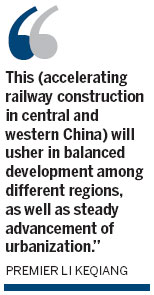
Premier outlines new methods, quicker construction in key areas
Premier Li Keqiang called on Wednesday for reform of funding methods for railways and for accelerated rail construction in central and western regions.
Experts said the measures are part of efforts to stabilize economic growth, which slowed to 7.5 percent in the second quarter, and will help China's industrial sector amid the economic slowdown.
The railway construction market will be "fully opened" through reform, and the building of rail facilities in less-developed areas will be emphasized, Li said at an executive meeting of the State Council, China's cabinet.
"This will usher in balanced development among different regions, as well as steady advancement of urbanization," he said.
The premier called for multiple fundraising sources for railway construction, including a greater role for private capital and the establishment of a railway development fund.
Intercity railways' ownership and management rights will be open to private and local investors, Li said, while calling for rail projects under construction to be completed on schedule.
The reform move follows the establishment of the China Railway Corp in March, after a separation of the now-defunct ministry of railways' government and enterprise functions.
China Railway Corp still faces uncertainties, as its financial report in the first quarter showed it has debts of more than 2.8 trillion yuan ($456 billion), which are rising each month.
Under the development plan drawn up by the former railways ministry, 5,200 km of track was to be completed this year, with a fixed-asset investment of 650 billion yuan. But only one-third of the investment was made in the first half of the year.
Luo Renjian, a researcher at the Institute of Transportation Research under the National Development and Reform Commission, said the slower pace of railway construction in the first six months is due to seasonal factors. It will pick up later this year and in the remaining years of the 12th Five-Year Plan (2011-15).
"Total railway investment this year will be 690 billion yuan, slightly higher than budget," he said, adding that about half of the funding will come from bank loans, with local governments and private investors spending about 90 billion yuan.
Other major funding sources include the railway development fund, income from car purchase tax, financial support from the central government, while the China Railway Corp will be responsible for providing 23 billion yuan, he said. "All funding is guaranteed."
Combined railway investment in 2014 and 2015 will be 1.4 trillion yuan under the National Development and Reform Commission's plan, he said, adding that the overall distance covered by the nation's railway system will be 123,000 km by 2020, about 3,000 km more than scheduled.
The central government is encouraging the start of new rail projects, especially in western areas where there is more room for development, instead of just focusing on existing ones, Luo said.
Wang Mengshu, deputy chief engineer of the China Railway Tunnel Group and a member of the Chinese Academy of Engineering, said the China Railway Corp has been less aggressive in construction after the March reform.
But the central government will still be responsible for the majority of funding for future investment, Wang said, as private investors are not yet convinced that they should chip in and investment in western areas is not profitable in the short term.
Xin Dingding and Cui Jia contributed to this story.